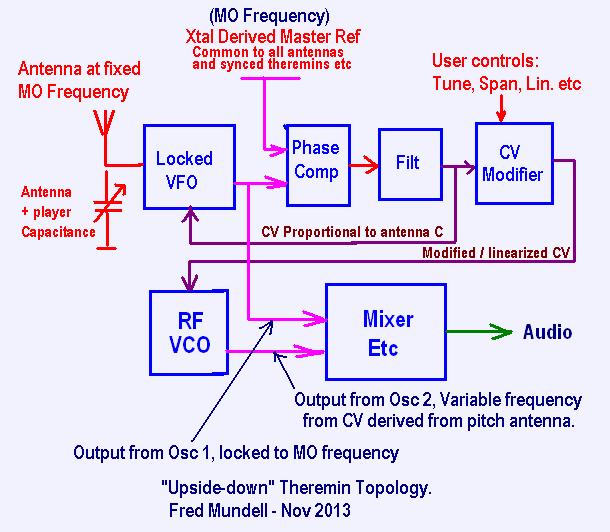A number of threads are ongoing at the moment, which IMO have common subject matter - I have found it difficult to keep these threads "in my mind" and find myself needing to go looking for "background" data to understand whats being said currently -
I have presented what I think may be a new theremin topology, but "published" this on Dewsters "Let's Design and Build a (mostly) Digital Theremin!" thread, and dont feel that I should hijack this thread anymore - I may add loads more stuff on that here.. Also, just as I find it difficult to locate things posted in an "off topic" location, others may find locating this topology difficult in a thread presently at 39 pages long...
>> Link to first disclosure at TW of my proposed theremin topology on Dewsters "Digital Theremin" thread << Full details can be found in pages 37 to 39 of this thread.. Below is the block diagram of this topology:

The matters I have found most interesting and possibly related were Dewsters ideas on his AFE (Analogue Front End) for his Digital Theremin, and in particular his series LC oscillator and "tankless" ideas.
It all starts here (well, actually, it probably starts early in the wonderful "Digital Theremin" thread: "Tanks" For Nothing!" (but this thread IMO loses direction)
Then some more discussion on CMOS oscillators and particularly Series vs Parallel - This is where I thought that Dewsters oscillator may be a good choice for my new "upside down" topology..
"Tell us about your experience with Open.Theremin Page 3 to 5"
And then moved into "Let's Design and Build a (mostly) Digital Theremin! Page 37 to 39"
This thread is a sort of continuation from where I left off there - but this does not mean I have 'left' that thread, just that I dont want to put any more OT stuff on it!
At this time I am at the design and simulation stage of my "Upside Down" theremin, NOTHING has been physically built! -
I will publish everything here - I think a lot of stuff (with adaption) may be of use for both analogue and digital theremins.. In particular, I think that my foray into a perhaps novel means of electronic tuning (utterly inspired by Dewsters ideas) may hold a lot of promise.
Fred
Ps - Last time I used the word "new" in a posting on this forum, I got jumped on by the "heavy's" -- "its not new, its used in GHz oscilloscopes" "its a simple heterodyning mixer" and other similar BS -
So let me just say this once - unless you can show me a THEREMIN that uses this topology, or a prior publication of this idea FOR THEREMINS, PLEASE SHUT UP!!!!! - I REALLY get pissed off by some people here who have little imagination, but seem to get off on discouraging those who think "out of the box".
I fully accept the possibility that someone else may have published or implemented "my" "upside down" theremin idea before me, and if you are aware of someone having done this, I want to know.. But dont go telling me its not "new" because (for example) something which may similar is being used in some communications reciever or submarine sonar system!
Also, I really am not interested in anyone from TW (or elsewhere) , who has not produced, displayed, published or discussed this idea PUBLICLY, claiming that they have been working on this idea before me. If you do stuff in secret, and someone publishes or patents the idea before you, well - tough luck! - If I am the first to disclose an idea, then I deserve the credit ! (for what thats worth - which is mostly nothing)
One reason for publishing ideas is to place them firmly in the public domain, so that they cannot be patented by anyone. Another reason is so that, even if I am never able to bring the ideas to production, the time I spent might not be completely wasted - Someone else may, at some future time, make use of them.





